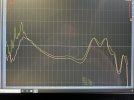I think most of us don't. Speaking for myself, I am only an audio enthusiast and not a mixing engineer. Now that you have pointed it out, along with your earlier posts about the importance of portability, I am beginning to see how difficult it would be for you. Applying EQ before the DAC is no problem for most of us because we only have 2 channels and we listen at home. I can't begin to imagine how difficult it would be to have to handle 16 channels and sitting in a hotel room.
The reason I posted the article written by Mitch is to provide you with reassurance that there are some other mixing engineers who feel the same way that you do. If you are used to mixing with a ruler flat frequency response, and if that is a requirement for a headphone for your profession, then any headphone tuned for mass market preference will have too much bass for you. So perhaps the problem with the U12t is that it is a product aimed for the mass market, and tuned to the Harman curve which is the preference of the mass market, and does not have tuning which is applicable for you as a mixing engineer.
As for your other question, whether they are tuned to the Harman frequency response, the answer is contained within the article:
The answer is a no. This kind of FR would earn it a headless panther on ASR and there would be the usual ASR pile-on about expensive and inferior products, which is quite unfair in my opinion. You saw a bit of that in this thread. Amir hasn't reviewed it, but there is a separate discussion on ASR
here. I have heard the Audeze LCD-4 but not the LCD-5, and again it is not to my preference. To me they sound too thin. But then I am a mass market consumer who likes the Harman curve.
I am not suggesting you buy an Audeze LCD-4/5, or a HD800S, because there may be other considerations besides frequency response (e.g. portability, sensitivity, etc). I am suggesting that your preference might be different to the rest of us given your profession. Maybe you should seek out headphones with a similar ruler flat frequency response and see what you think.



